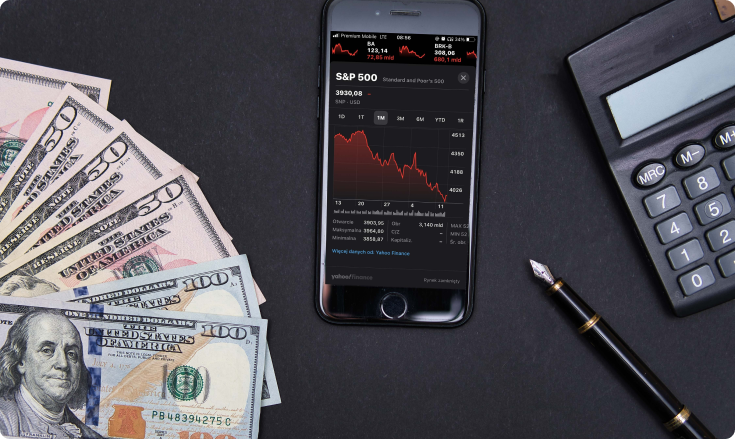What Are Indices And Why Trade Them?

What are indices?
Indices measure the performance of a group of stocks, bonds or other investments. These investments are often grouped around a particular industry, like tech stocks, or even the stock market overall. An index collects data from a variety of companies across industries. Together, that data forms a picture that helps investors compare current price levels with past prices to calculate market performance. Each index serves a unique purpose because different investors are interested in different sectors. Some indexes focus on a smaller subset of the market, and some are more general thus referring to the market overall. Indexes also vary in size, with some tracking just a handful of stocks and others looking at thousands.
How are indices weighted?
Each stock in an index has a weighting assigned to it. Stocks with higher weightings have more influence on the index's movements than those with lower weightings. There are three different ways that indexes typically assign weightings to their stocks:
- Price-weighted indexes give more weight to companies with higher stock prices. For example, in a hypothetical index made up of three stocks with share prices of $60, $30, and $10, the $60 stock would make up 60% of the total index, regardless of the relative size of the company. The Dow Jones Industrials is the most important example of a price-weighted index.
- Market-capitalization-weighted indexes give more weight to companies with higher market capitalizations. The market value for each stock is calculated by multiplying its price by the number of shares included in the index, and each stock’s weight in the index is determined based on its market value relevant to the total market value of the index. For example, let’s take a hypothetical market, consisting out of 5 stocks, with the total market value of $970. Now, according to a market-capitalization formula, if one of the 5 stocks has a share price of $3, and there are 50 shares of this stock in the index, its market value will be $150 ($3 X 50 shares = $150). This will further bring us to this stock’s weight in the index, which in this case will be 15% ($150 / $970 = 15%). Both the S&P 500 and the Nasdaq 100 are market-cap weighted, and large companies like Apple and Microsoft have much greater weightings than the smaller companies that make up the indexes..
- Equal-weight indexes give the same weighting to each stock, regardless of price, market capitalization, or any other factor.
For the most part, market-cap-weighted indexes are most prevalent, as they're often the easiest for index funds to track.
Types of indices
There are many market indices in the world; the number of US Indices alone exceeds 5000. Stock market indices specifically can be segmented into five fundamental categories according to coverage:
- Country indices: these types of indices track the course of nation-specific indices, and by default, are a reflection of the market sentiment of a given country. Examples of country indices include, but are not limited to the DAX40 which tracks 40 of Germany’s blue-chip stocks, the Nikkei 225 which gauges 225 stocks of Japan’s top-tier companies, and more.
- Global indices: these indices cover the worldwide market moves and are international. Global indices include the S&P Global Index, among others.
Other indices include regional indices, exchange-based indices, and sector-based indices.
What are the most traded indices?
Out of the many types of indices, there are some that are considered the most popular worldwide. Here is the list of the most traded indices globally:
- The Dow Jones Industrial Average (DJIA) is one of the oldest, most well-known and most frequently used indices in the world. It includes the stocks of 30 of the largest and most influential companies in the US. The stocks within the DJIA come from a range of industries, from healthcare to technology, but are united by all being blue chip stocks. This means they have a history of strong financial performance. It is a price-weighted index. In case the average price of the 30 companies goes up, the DJIA becomes higher as well. If the average price of the 30 companies drops lower, the DJIA will decline too. indices in the US and the whole world.
- The S&P 500 index (known commonly as the S&P 500) is an index with 500 of the top companies in the US Stocks are chosen for the index primarily by capitalization but the constituent committee also considers other factors including liquidity, public float, sector classification, financial viability, and trading history. The S&P 500 index represents approximately 80% of the total value of the US stock market. In general, the S&P 500 index gives a good indication of movement in the US market as a whole. The S&P 500 index is a capitalization-weighted index. Therefore, every stock in the index is represented in proportion to its total market capitalization. In other words, if the total market value of all 500 companies in the S&P 500 drops by 10%, the value of the index also drops by 10%.
- The Nasdaq 100 Index is a basket of the 100 largest, most actively traded US companies listed on the Nasdaq stock exchange. The index includes companies from various industries except for the financial industry, like commercial and investment banks. These non-financial sectors include retail, biotechnology, industrial, technology, health care, and others. The diversity of companies included in the Nasdaq 100 helped drive strong returns for the past two decades. The Nasdaq 100 Index has produced excellent results. In the last 15 years, the Nasdaq 100 Index has grown at a compound annual rate of nearly 16%.
There are other indices such as hundreds of global, country and region-specific indexes including MSCI World, Japan's Nikkei 225 ect.
All of them are based on different stocks and vary in the number of companies as well as how they are weighted inside an index.

Why trade indices?
Indices trading means that you are taking a position on a stock index – which is a measure of the performance of several different companies. Indices trading can be a way to get exposure to an entire sector or economy at once, without having to open positions on lots of different shares. The most popular way to trade indices is via CFD.
Indices trading is popular for a number of reasons. Some of the main advantages of indices trading include:
- Plenty of trading opportunities: stock indices are constantly moving up and down during market hours which means there are always plenty of opportunities for traders and investors to capitalize on.
- The ability to trade in both directions: when you trade indices with CFDs, you have the ability to trade in both directions. You can go long (buy) an index in order to profit from upward price movements, or you can go short (sell) an index, in order to profit from downward price movements.
- You only need a small amount of capital to start trading: a key advantage of CFDs is that they enable you to use ‘leverage’ to control a larger amount of money than you have deposited for the trade. For example, with leverage of X2, you can control $2,000 with $1,000. This means that you can start trading indices with a relatively small amount of capital.
- Natural bias to the upside: besides the often brief but sharp sell-offs, stock indexes do actually spend most of the time in uptrends.
- Leverage can boost your gains: leverage is a powerful tool that can potentially magnify your trading profits. However, leverage can also increase your losses, so it’s important to be aware of the risks.
- Less hassle than trading individual stocks: with indices trading, you don’t need to worry about studying individual companies’ reports or analyzing their financials before you trade. This means that trading indices can be less time-consuming than trading individual stocks.
- Less risky than trading individual stocks: trading indices is also generally less risky than trading individual stocks because you’re effectively trading a whole basket of stocks. This means that you’re less exposed to individual company risks.
- Indices can be used to reduce portfolio risk: trading indices can be an effective way to hedge portfolio risk. For example, if you own a portfolio of stocks but are concerned that the stock market could fall temporarily in the short term, you could open a short index trade in order to profit if the market falls. If the market does fall, the short index trade will increase in value, offsetting the losses on your stocks.
What to consider when picking an index?
A stock index’s price is determined by the movements of the shares it tracks. Here are a few factors to watch out for when deciding which index to pick and which direction to trade in:
- The political climate: politics can have a significant impact on stocks. Elections can mean a change of policy that could bring headwinds or tailwinds for business, international tension could bring tariffs and more.
- Company announcements: a new CEO, merger or earnings release at a key stock will often play out on the index it tracks.
- Economic data: employment data, central bank announcements and inflation rates all offer clues to how an economy is performing – and demand for shares in strong economies is often higher.
- Industry news: if a headline impacts several large companies in a sector – e.g. mining or banking – then expect it to impact their broader index too.
Conclusion
Even though there is much less hype nowadays about trading with indices in comparison with currently more popular assets, it should not be underestimated whatsoever. Yes, other markets might be more exciting, moving faster and stronger, but the undoubtful benefits of index trading should be taken into consideration as well. And because intraday volatility with index trading is lower, those who haven't quite yet mastered the psychological aspects of trading can still find early success.
Take a look at our Trading Conditions and start Trading Indices now.
Sources:
1. Banton, C. An introduction to US Stock Market Indices. https://www.investopedia.com/insights/introduction-to-stock-market-indices (2022)2. Vaneck. How is an Index Constructed? https://www.vaneck.com.au/globalassets/home.au/special/education-new/vaneck_how-is-an-index-constructed.pdf (2021)
3. Plus 500. What Are The Most Traded Indices? https://www.plus500.com/en-ME/Trading/Indices/What-Are-the-Most-Traded-Indices~2 (2022)
4. Tretina, K. Investing Basics. What Is A Market Index? https://www.forbes.com/advisor/investing/stock-market-index/. (2022)
LimitPrime © 2026
Begin to invest and
start earning today!
Categories
Do you need personalized assistance?
READ MORE INTERESTING ARTICLES

Diversificationnoun the action of diversifying something or the fact of becoming more diverse. a trading strategy that reduces risk. D...
Read More
As any risk disclosure will tell you, trading financial instruments put the trader at risk of losing some or all of their allocated cap...
Read More
Electronic currency is non-tangible money that exists in your bank account and can be used for various payments. In essence, it’s an el...
Read More